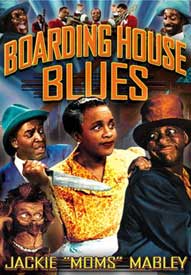 Dusty Fletcher & Jackie "Moms" Mabley get first & second billing in Boarding House Blues (1948), one of the best of the independent black-cast musical comedies.
Dusty Fletcher & Jackie "Moms" Mabley get first & second billing in Boarding House Blues (1948), one of the best of the independent black-cast musical comedies.
Although filmed without a budget & with poor sound equipment, it nevertheless has such an amazing line-up of talent that in its own fuzzy worn-out copy way, it's simply a great film.
Dusty & Moms were leading comics in black vaudeville. Dusty was a household name among black folk though almost unknown to white folk.
Moms had some cross-over fame for her "blue" comedy records & a very few appearances in her old age on television, but only African Americans really appreciated the fact that she truly was a signal stand-up comic of the first water, one of the first female comic geniuses in the industry.
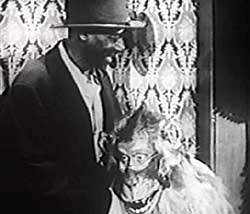 As Dusty & Moms were out front on this project, they dragged along with them a great many other vaudeville comics from the chitlin circuit. Thus Boarding House Blues comes off as a sampler of routines for some of America's finest comics, who, due to institutionalized racism, did not get the full media exposure their talents deserved. As Dusty & Moms were out front on this project, they dragged along with them a great many other vaudeville comics from the chitlin circuit. Thus Boarding House Blues comes off as a sampler of routines for some of America's finest comics, who, due to institutionalized racism, did not get the full media exposure their talents deserved.
The film opens with Dusty arriving home, at Moms' boarding house, bringing with him a huge monkey that begins climbing all over the place.
Moms is kind of tired of Dusty's menagerie -- he already has a rabbit & a miniature bear upstairs, as part of an alleged act he never quite gets going.
Moms, Dusty, & the guy in the monkey suit do comedy bits together in the foyer of the boarding house.
The guy in the monkey suit (John Riano) pretty much stays in character until the last scene of the movie, when he's revealed to be a man merely disguised as a monkey. And that man is "Richard," referencing the unseen character in Dusty Fletcher's most famous routine, happily preserved as a short subject, Open the Door, Richard (1945).
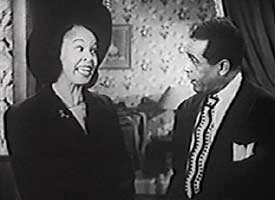 Vivian Harris, known as "the voice of the Apollo," puts in an appearance with John "Spider Bruce" Mason & their mutual friend Charlie to perform a long three-part skit straight from the burlesque theater.
Vivian Harris, known as "the voice of the Apollo," puts in an appearance with John "Spider Bruce" Mason & their mutual friend Charlie to perform a long three-part skit straight from the burlesque theater.
Vivian was kind of a specialist in what was called "the talking woman" of Burlesque, the girl who didn't strip but who played straight-man (or straight-woman) to the baggy-pants clowns. Vivian can be seen playing a similar role opposite top comedian Pigmeat Martin in Burlesque in Harlem (1954).
Spider Bruce is so caught up in his established act that he has barely changed a thing to make it fit the film context; at one point makes a reference to the audience's presence.
The act is called "Gimme" & its centerpiece is a rap-song of that title. The bit involves Spider loaning an extra suit of clothes to Charlie but then both men compete to take Vivian to a dance. Spider will take back his loaned garments one by one, singing "Gimme" until Charlie's standing in only his undershirt & BVDs.
Spider Bruce had been doing stand up as a "black face" comic since the '20s. When the era of African American comics in burnt-cork make-up had passed, Spider changed with the times & remained a chitlun circuit big draw. He was regarded one of the top three baggypants clowns, along with Pigmeat & Dusty, though generally only black audiences knew them.
He claimed that Dusty Fletcher's best-known routine "Open the Door, Richard" was originally his own act in the 1920s, & that Dusty stole it.
But the two baggy pants clowns must've come to good terms on this, as when bandleader Jack McVea put the comedy routine to music in 1947, the words were credited to Jack, Dusty, & John Mason aka Spider Bruce. Later still, Dusty invited Spider to do one of his most elaborate routines for Boarding House Blues, so I'd guess there were no hard feelings about any of it.
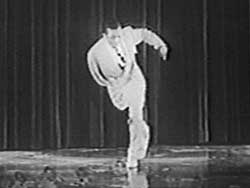 As the tale unfolds, Moms' boarders, all theater people, have never really been in a position to pay their rent.
As the tale unfolds, Moms' boarders, all theater people, have never really been in a position to pay their rent.
She has carried them happily because she loves theater people, they are just like family. But now her own insurance money has run out, & she can't pay their way for them.
She doesn't own the house & the landlord Simon (Emery Richards) is a rank villain who wants to throw her & all her boarders out, unless her most beautiful young tenant Lila (Marie Cooke) will agree to marry him.
It's a slim plot device but all that matters is how this becomes the excuse for putting on a Follies Review to raise money to save Moms' boarding house. Pretty much the rest of the film is a series of specialty acts from vaudeville, except for the closing "mainstream" superstar, Lucky Millinder with his orchestra (Lucky's band is obviously filmed on a completely different stage than everyone else).
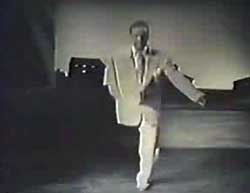 The first act on stage is billed here as "Crip" Heard, a one-arm, one-legged dancer who in the following decade would prefer to be billed as Herbert "Henry" Heard. He gives a very smooth performance & despite the "freak show" element, it's very cool. The first act on stage is billed here as "Crip" Heard, a one-arm, one-legged dancer who in the following decade would prefer to be billed as Herbert "Henry" Heard. He gives a very smooth performance & despite the "freak show" element, it's very cool.
There's one other visual record of Henry Heard's abilities that I know of, in an episode of the 1950s television series You Asked For It.
It's a four minute performance during which Henry tap dances, does the rhumba, & the boogie woogie. In both Boarding House Blues & You Asked For It, he proves himsef even with one leg & one arm one hell of a cool dancer, freaky or not.
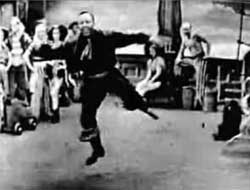 I can't resist an aside about Clayton "Peg Leg" Bates who was an even bigger name in one-legged tap dancing. I can't resist an aside about Clayton "Peg Leg" Bates who was an even bigger name in one-legged tap dancing.
Bates had "two" legs sort of, it's just that one of them was a wooden pirate-peg. He appeared twenty-two times on the Ed Sullivan Show, once with a routine that had him dressed literally as a tapdancing one-legged pirate doing "the Harlem hornpipe," & was he great.
On another episode, Peg Leg Bates tapped in a competition act, alongside Little Buck, who was no longer little by then. Buck can be seen tapping in the Rhythm & Blues Review (1955).
I've included three photos, one of Henry Heard from Boarding House Blues, followed by Henry from You Asked For It, & then for contrast Peg Leg Bates from the Ed Sullivan Show. There may never again be the likes of these guys, as there'll never again be vaudeville.
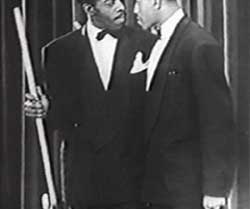 After one-armed one-legged Henry it's time for the Berry Brothers to strut their stuff. There was a third brother, James Berry, who appears with Nyas & Warren in Panama Hattie (1942) & Lady Be Good (1941), but not in later appearances.
After one-armed one-legged Henry it's time for the Berry Brothers to strut their stuff. There was a third brother, James Berry, who appears with Nyas & Warren in Panama Hattie (1942) & Lady Be Good (1941), but not in later appearances.
Singing with rhythm & soul the Harry Warren/Mack Gordon number "You'll Never Know" is only the tip of the talent embodied in these two guys. They tap, slide, & even boogie-woogie together, & show off some breakdance athleticism that is just bogglingly modern & amazing.
The Berry Brothers & the Nicolas Brothers had in 1938 staged a "battle of the tapdancing brothers" at the Cotton Club. It was a famous event that got people arguing which brothers were the best.
Truth be told, there is no question the Nicholases were the best tapdancers that ever existed. But the Berry Brothers had a few extra athletic stunts. They couldn't always make the acrobatics look like dancing the way the Nicholas brothers always did, but they pushed the envelop of physical endurance.
Up in Harlem the tapdancers were so damned good even the "second best" were too good for words.
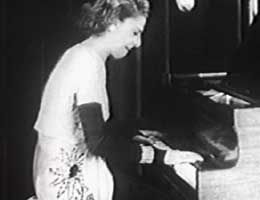 The absolute best of the great acts in this film is next up. Una Mae Carlisle sits coy & beautiful at a piano proving her jazz musicianship, backed by a guy with a slap base & another guy with a guitar.
The absolute best of the great acts in this film is next up. Una Mae Carlisle sits coy & beautiful at a piano proving her jazz musicianship, backed by a guy with a slap base & another guy with a guitar.
This protege of Fats Waller sings a spectacularly cool jump-jazz number written by Louis Armstrong & Billy Kyle, the complete lyric for which is:
"My style is breezy/ And my smile is teasy/ If you think I'm easy/ Throw it out your mind./ Should your heart start hurtin'/ Wonderin' if I'm flirtin'/ And your head's uncertain/ Throw it out your mind.
"Why, anyone can plainly see/ Unless they are blind/ That I'm yours exclusively/ I'm the one-track kind!/ If you're out without me/ Never worry 'bout me/ And if at times you doubt me/ Throw it out your mind."
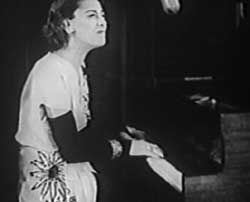 She gets a second number, another fine jump-jazz tune, this one written by trumpeter & singer Oran "Hot Lips" Page & a hit for Una. Because I love both her songs so much I'm giving the complete lyric for this one too: She gets a second number, another fine jump-jazz tune, this one written by trumpeter & singer Oran "Hot Lips" Page & a hit for Una. Because I love both her songs so much I'm giving the complete lyric for this one too:
"There's a present expression in Chicago now/ It's a funny thing but it's caught on somehow/ No, it ain't like that, what you bet. It aint like that, what you bet, I say/ Yes, I said that.
"So if you're hep/ Watch your step/ Just save your rep/ It ain't like that I say/ Yes I said that./ Now tell me honey does two make three/ When in reality/ Seein' is believing & hearin' is deceiving/ No it ain't like that, ABC/ You follow me, it ain't like that, I say/ Yes, I said that."
The arrangement includes her boogie/stride piano solo. What an extraordinary entertainer she was, with physical beauty & a sweet & exciting voice. Sadly she always suffered from mastoiditis throughout her career, & died rarther young in 1956.
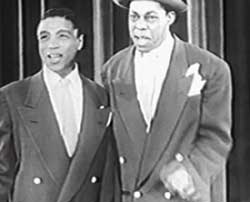 Stump & Stumpy are on after Una Mae, doing a jump-jazz number pojpular at the time, "Swing for Sale" composed by Sammy Cahn & Saul Chaplin.
Stump & Stumpy are on after Una Mae, doing a jump-jazz number pojpular at the time, "Swing for Sale" composed by Sammy Cahn & Saul Chaplin.
Though Stump & Stumpy are commedians foremost, they're also right fine singers, the music not at all ruined by the fact that they're funnier'n all hell. And if singing & comedy greatness ain't enough to brag about, they were also amazing tap dancers, with some very witty choreography bound to win broad smiles.
Stump & Stumpy were a great comedy team, consisting of the rather short James "Stump" Cross & the very short Eddie "Stumpy" Hartman. They were all-rund entertainers, jazz singers, tapdancers, & funnymen extraordinaire.
They were sometimes called the black Martin & Lewis, but fact is, Jerry Lewis borrowed a lot of his "silly" character from watching the character of "Stumpy." So Martin & Lewis would more properly be called the white Stump & Stumpy. Stump & Stumpy's manager Nat Nazarro said Lewis & Martin just flat-out stole the act, & once interrupted a live performance to shout his disapproval from the aisles.
Their names for the act were of a type. In their agent's stable were also Moke & Poke (who can be seen as Lucifer Junior's minions in Cabin in the Sky, 1943) & Chuck & Chuckles, aka Buck & Bubbles, each duo mixing superb tap talents with absurd comedy.
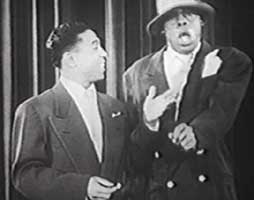 Stump & Stumpy were a huge draw on the chiltlin circuit & in black nightclubs & on burlesque stages, comics "back in the day" being as important as strippers to burlesque. It may seem surprising today, but burlesque was workin' class entertainment for the masses, including couples I& women, not just for men. And the comics no matter how whimsical were frequently treated like heart-throbs. Stump & Stumpy were a huge draw on the chiltlin circuit & in black nightclubs & on burlesque stages, comics "back in the day" being as important as strippers to burlesque. It may seem surprising today, but burlesque was workin' class entertainment for the masses, including couples I& women, not just for men. And the comics no matter how whimsical were frequently treated like heart-throbs.
By the time they made Boarding House Blues, James & Eddie were at the end of their partnership. Soon after, Harold Cromer became Stumpy. Harold happens also to be in Boarding House as Moofty, the little guy who tries to move out of the boarding house without paying, disguised in drag.
Eddie had alas become a severe alcoholic & heroin addict. Even though he created the great character that both Harold Cromer & Jerry Lewis would thereafter imitate, he was simply too unreliable & had to be replaced. It's not inconceivable that the theft of so much of the Stump & Stumpy act by Lewis & Martin, together with the color barrier that just generally held them back, was harder on Eddie, though who is to say why drugs take down so many artistic souls.
James was no teetotlar himself & a story goes that when he & his new partner Harold were performing at Storky's, James was so drunk he fell into the orchestra pit & damaged Dizzie Gillespie's horn.
To do that to a musician's livelihood was a fiercely evil thing & Jimmy took a lot of heat from short-tempered Dizzy & disapproval from friends. But in time Dizzy would admit it was a lucky day as the bent horn became a trademark that helped him stand out.
Entering the 'fifties with a new partner, James & Harold had some crossover success that evaded James & Eddie. They were never quite household names except in black households, where it was just a flat-out known fact that they were the best of all American comics of their day, spectacular all-round entertainers.
The new partnership got Stump & Stumpy regular appearances on early television variety shows, The Steve Allen Show, Kate Smith Hour, & Milton Berle's Texaco Show. They played bit parts in James Arnes's Gunsmoke & Jack Webb's Dragnet, & opened for Frank Sinatra at the Paramount in Vegas.
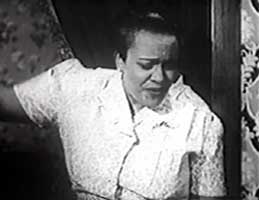 Moms Mabley gets her spot, backed by the jazz of the Lee Norman Trio. Her stand-up routine is still funny these decades later, about a time when she got hired as a maid to royalty, & why she got fired. Moms Mabley gets her spot, backed by the jazz of the Lee Norman Trio. Her stand-up routine is still funny these decades later, about a time when she got hired as a maid to royalty, & why she got fired.
She then slams Cab Calloway for having once called her a dog. She'd like to be a dog, & Cab Calloway would be her tree. It did make me wonder if she really was mad at Cab over something.
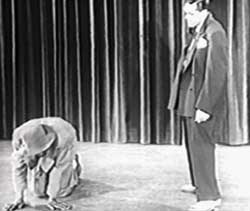 Moms was simply a fabulous old dyke, though really she looks a lot younger & nicer here than in most of the photographs & performances that remain of her, cuz for one thing, she's got her teeth in. Moms was simply a fabulous old dyke, though really she looks a lot younger & nicer here than in most of the photographs & performances that remain of her, cuz for one thing, she's got her teeth in.
She closes with an old-lady version of tapdancing, laughing & mumbling to herself about her age.
Moms is followed by the comedy team of Lewis & White. They were "round the world" chitlun circuit regulars since the 1920s, playing everywhere from the Apollo in Harlem to the Orpheum in Seattle. In the late '40s they toured with the Ink Spots, & were headliners at the Strand Theater on Broadway.
For this routine, one of 'em is drunk, the other sober, & the first half of the act is mainly insult humor. They'll eventually perform a crazy jitterbug together, & close with a comic-gangster routine.
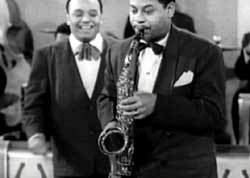 The final act is Lucky Millinder's orchestra, a full reel to himself. This has the feeling of a completely different short subject. I think there's every likelihood that when his five numbers were filmed, it wasn't yet known they'd be included as part of Boarding House Blues, as it comes close to looking like a Vitagraph musical short complete in itself.
The final act is Lucky Millinder's orchestra, a full reel to himself. This has the feeling of a completely different short subject. I think there's every likelihood that when his five numbers were filmed, it wasn't yet known they'd be included as part of Boarding House Blues, as it comes close to looking like a Vitagraph musical short complete in itself.
Nearly every other act we've seen has been a great record of top vaudeville acts of black entertainment of the '30s (Una Mae is another exception, playing top clubs & cabarets in the US & Europe). Lucky was a complete cross-over act with mainstream appeal. And he put on great shows.
His first number with the orchestra is an instrumental, title uncertain. Lucky bounces in place conducting the band while a saxophonist stands front & center on a jazz solo, followed by duelling trumbones, then muted trumpet solo.
The arrangement is designed to let several bandmembers show off one after another. When the whole band is going full steam, Lucky's twirling & kicking & strutting to the conclusion. This number is followed by three more, each featuring a different singes, then Lucky will close with another instrumental, called "Do the Hucklebuck."
But before that finale, we are given those three incredible vocal performances, superb singers with just the best big-band back-up.
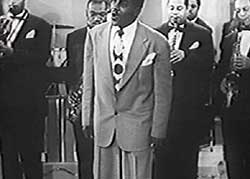 Lucky first recorded "Sweet Slumber" in 1945 with a different vocalist than in the Boarding House Blues version.
Lucky first recorded "Sweet Slumber" in 1945 with a different vocalist than in the Boarding House Blues version.
It starts off as a lullaby with saxophist stepping out of the band for a sleepy-blues solo. Then all the saxes from Lucky's amazing brass section step out from the band to swell the slow swing rhythms, & what an impression they make, both visually & for sound.
Eventually Paul Breckenridge strolls center stage for the vocal. His light suit & flashy tie make him stand out strikingly against the much more formally clad band in black suits.
Paul was a crooning tenor & though Lucky's instrumental arrangement had ranged from blues to swing, Paul makes it a totally romantic melody. It all holds together beautifully & has a little bit of an Ink Spots sound to it.
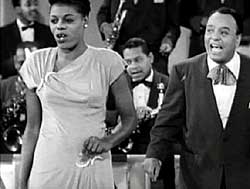 Up-tempo R & B is definitely showing signs of the coming Rock & Roll era when when slim, tall Anistine Allen steps center stage to sing a call & response with Lucky & the orchestra: "Let it roll, let it roll (all night long)/ Let it roll, let it role (all night long)..."
Up-tempo R & B is definitely showing signs of the coming Rock & Roll era when when slim, tall Anistine Allen steps center stage to sing a call & response with Lucky & the orchestra: "Let it roll, let it roll (all night long)/ Let it roll, let it role (all night long)..."
This could easily be adapted as a rock & roll number, even though it's only 1948, & Lucky's arrangement is halfway between swing band & rhythm & blues. It is in any case a great, great, great performance.
At the big sax solo, Anastine & Lucky shimmy together very endearingly before Anistine finishes her vocal. Oh, & she's got a space dead-center in her teeth, how sexy is that.
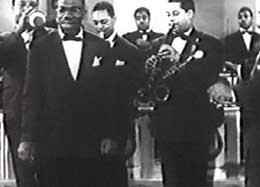 "I Love You, Yes I Do" (sometimes just "Yes I Do") has Lucky & his orchestra backing up "Bull Moose" Jackson.
"I Love You, Yes I Do" (sometimes just "Yes I Do") has Lucky & his orchestra backing up "Bull Moose" Jackson.
The number opens with one of Lucky's trademark brass arrangements with trumpet & two saxes out front, doing a slow-dance bit of swing that the muted trumpet comes to dominate.
Then out strolls Bull Moose carrying a clarinet which he hands to one of the saxophonists before moving center-front of the stage to sing.
With a name like Bull Moose you'd think he'd have a more aggressive image, but he's got just the sweetest damn romantic tenor reminiscent of the Platters or the Inkspots.
Everything Lucky arranges for Boarding House Blues is just mightily good stuff, but I think this one's my fave because of the utter sweetness of Bull Moose's voice, on a really pleasing song.
This was also the first time it ever occurred to me that group doowop grew out of solo performances like this, when instead of harmony back up there were gentle arrangements for the instruments.
The sax, clarinet, & trumpet at Bull Moose's back are veritably the back-up voices equivalent to the vocal group harmony, & this is pre-doowop doowop just as "Let It Roll" is pre-rock rock & roll. And Lucky Millinder really was that cutting edge.
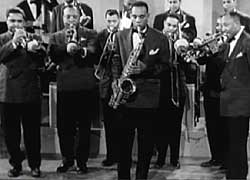 Lucky loved his brass players, so the fifth & final number, "Do the Hucklebuck" begins with three mute trumpets.
Lucky loved his brass players, so the fifth & final number, "Do the Hucklebuck" begins with three mute trumpets.
Lucky's conducting moves are charming, & I really expected him to bust into a dance of the era that was called the hucklebuck or huckabuck, but he never did.
Out comes the lead sax for a highly melodic solo, soon joined by plenty of brass. This song is a rhythm & blues classic of smooth jazz, though the dance referred to in the title was generally performed as raunchy swift boogie.
The extended boogie woogie piano solo does go pure stride while Lucky keeps strutting until a curtain closes. For more about this great band, see reviews of Paradise in Harlem (1939) & Lucky Millinder Short Subjects (1941 & 1946).
Now that the rent-raising show for Mom's boarding house is over, we get some awkwardly placed end-credits for some of the members of the Follies review we just saw. Awkwardly placed because it makes the film look like it's over, as it well could have been.
But there follows a coda, gathering together Moms' tenants. They're having a big celebration of their successful show. There's some come-uppance for the mean landlord, & a last-minute romantic element for happy ever after.
As it wouldn't quite be satisfying to just use these closing sequences to wind up plot elements nobody cared about, the very final scene takes us up to Dusty Fletcher's room for a final comedy routine, during which Moms will learn the monkey ain't a monkey.
copyright © by Paghat the Ratgirl
|
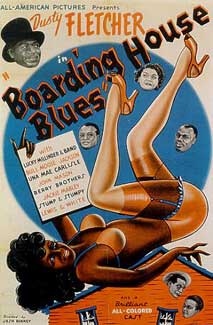

 As Dusty & Moms were out front on this project, they dragged along with them a great many other vaudeville comics from the chitlin circuit. Thus Boarding House Blues comes off as a sampler of routines for some of America's finest comics, who, due to institutionalized racism, did not get the full media exposure their talents deserved.
As Dusty & Moms were out front on this project, they dragged along with them a great many other vaudeville comics from the chitlin circuit. Thus Boarding House Blues comes off as a sampler of routines for some of America's finest comics, who, due to institutionalized racism, did not get the full media exposure their talents deserved.

 The first act on stage is billed here as "Crip" Heard, a one-arm, one-legged dancer who in the following decade would prefer to be billed as Herbert "Henry" Heard. He gives a very smooth performance & despite the "freak show" element, it's very cool.
The first act on stage is billed here as "Crip" Heard, a one-arm, one-legged dancer who in the following decade would prefer to be billed as Herbert "Henry" Heard. He gives a very smooth performance & despite the "freak show" element, it's very cool. I can't resist an aside about Clayton "Peg Leg" Bates who was an even bigger name in one-legged tap dancing.
I can't resist an aside about Clayton "Peg Leg" Bates who was an even bigger name in one-legged tap dancing.

 She gets a second number, another fine jump-jazz tune, this one written by trumpeter & singer Oran "Hot Lips" Page & a hit for Una. Because I love both her songs so much I'm giving the complete lyric for this one too:
She gets a second number, another fine jump-jazz tune, this one written by trumpeter & singer Oran "Hot Lips" Page & a hit for Una. Because I love both her songs so much I'm giving the complete lyric for this one too:
 Stump & Stumpy were a huge draw on the chiltlin circuit & in black nightclubs & on burlesque stages, comics "back in the day" being as important as strippers to burlesque. It may seem surprising today, but burlesque was workin' class entertainment for the masses, including couples I& women, not just for men. And the comics no matter how whimsical were frequently treated like heart-throbs.
Stump & Stumpy were a huge draw on the chiltlin circuit & in black nightclubs & on burlesque stages, comics "back in the day" being as important as strippers to burlesque. It may seem surprising today, but burlesque was workin' class entertainment for the masses, including couples I& women, not just for men. And the comics no matter how whimsical were frequently treated like heart-throbs.
 Moms was simply a fabulous old dyke, though really she looks a lot younger & nicer here than in most of the photographs & performances that remain of her, cuz for one thing, she's got her teeth in.
Moms was simply a fabulous old dyke, though really she looks a lot younger & nicer here than in most of the photographs & performances that remain of her, cuz for one thing, she's got her teeth in.



